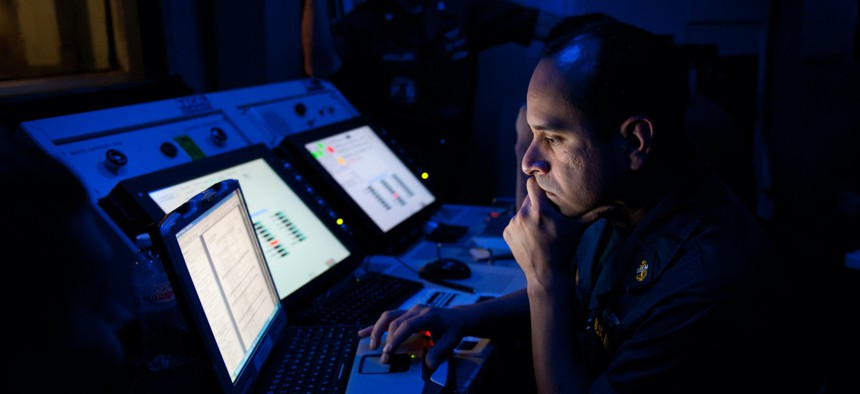
In this 2012 photo, Chief Aviation Machinist's Mate Eddie Casusol reviews test data from an F/A-18 engine test in the jet shop aboard the Nimitz-class aircraft carrier USS John C. Stennis. U.S. Navy / Mass Communication Specialist 2nd Class Charlotte C. Oliver
The Navy is drowning in data it doesn’t know what to do with
The service’s principal cyber advisor got candid about data struggles as it looks to adopt AI in operational plans.
The Navy hasn’t yet figured out how to make best use of the data it collects—and transmitting it while at sea is a chief concern.
“Transport is still that one thing that we kind of take for granted in this equation,” when talking about operationalizing data and artificial intelligence, Chris Cleary, the Navy’s principal cyber advisor, said Thursday. “The Navy doesn't drag [ethernet cables] behind it when it goes to sea. So, the availability of information, regardless of where it lives, is always a challenge.”
To adapt, the Navy has begun to adopt satellite communications services, like Starlink, “to be able to get to this stuff faster,” Cleary said. Last year, the Navy awarded Inmarsat nearly $1 billion for broadband satellite communications.
But making and keeping data trustworthy, secure, and usable is a near-universal struggle, even though the Defense Department has made it a priority in recent years.
“We've all acknowledged it's important. We're all doing it. We've all hired chief data officers and we're all talking about data strategies,” Cleary said of the military services collectively during a panel at the Billington Cybersecurity Summit. The Department of the Navy is “still struggling in one way, shape, or form over which data, what is important, how do you want to leverage it.”
Those questions haven’t been answered yet, but the Navy is “aggressively pursuing it” as it looks to pivot away from large complicated platforms to a “smaller, more distributed, attributable, autonomous force,” he said.
But such a pivot raises additional data questions, such as how to communicate between those disparate systems, what information should be collected, and how it should be distributed in a constrained environment.
“And those are all the things that the Department of the Navy is struggling with,” Cleary said.
The Navy has been consolidating its IT systems and sifting through related data for years. The service also released a Cyber Ready plan earlier this year to map out how to best harden its defenses using cloud platforms and services, implementing a zero-trust security framework with daily cyber monitoring, and making data ready-to-use for analytics.
Solving the data problem is essential to the Pentagon’s efforts to boost cybersecurity, such as its zero trust push that focuses on securing information rather than networks, and using AI and autonomous systems that need quality data to be useful.
Steve Faehl, Microsoft’s chief technology officer of security, said all of the work the Defense Department has done in gathering and centralizing data to train models will lead to a “complete transformation.”
“All the pre-work that's been done is the right work. But we're not going to spin our wheels as much moving forward, we're gonna see better results faster. And we also see the trainability of the workforce as you build that central knowledge base for your workforce out of your data. AI can bring that to them. And make them better at their jobs, help them perform above their level, above their training,” Faehl said.
But only operators on the ground should determine what data is truly useful, said John Sahlin, the vice president of cyber solutions for General Dynamics Information Technology.
“The best thing we can do is allow our warfighters the ability to make sense of the data that is relevant to them right then and there in the now. And any tools and capabilities we can provide them with the ability to make those decisions,” he said.







